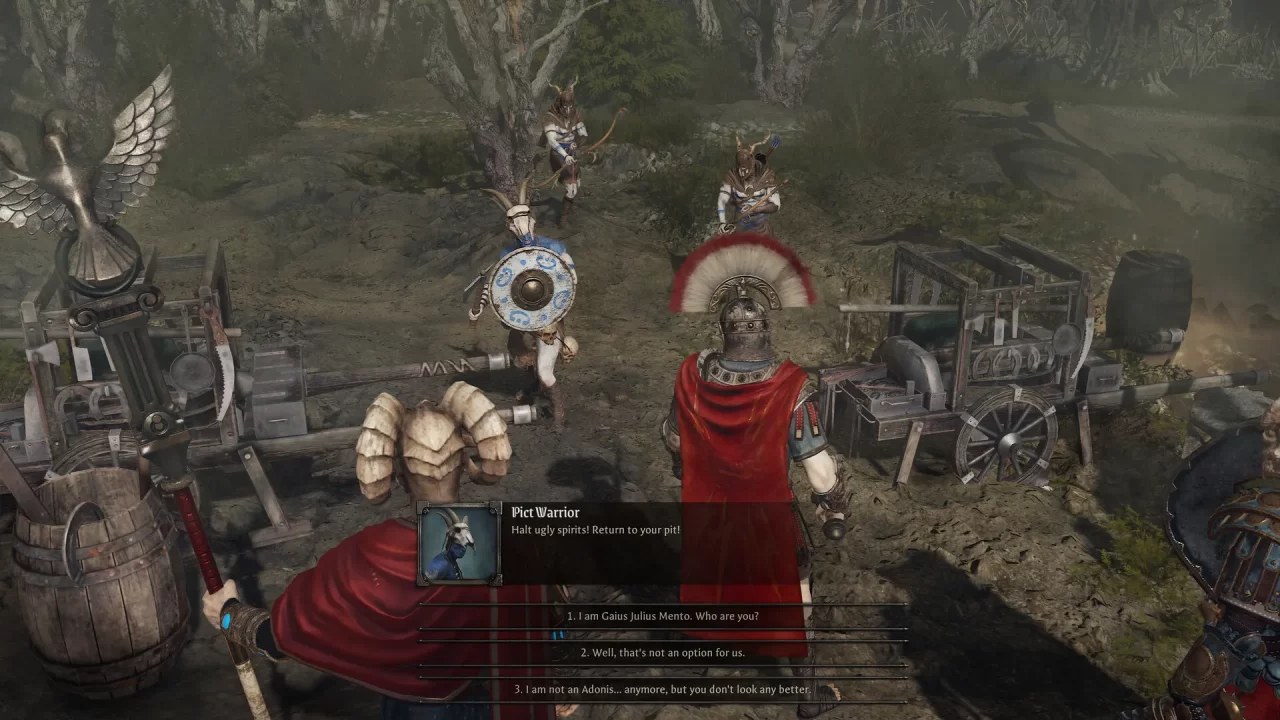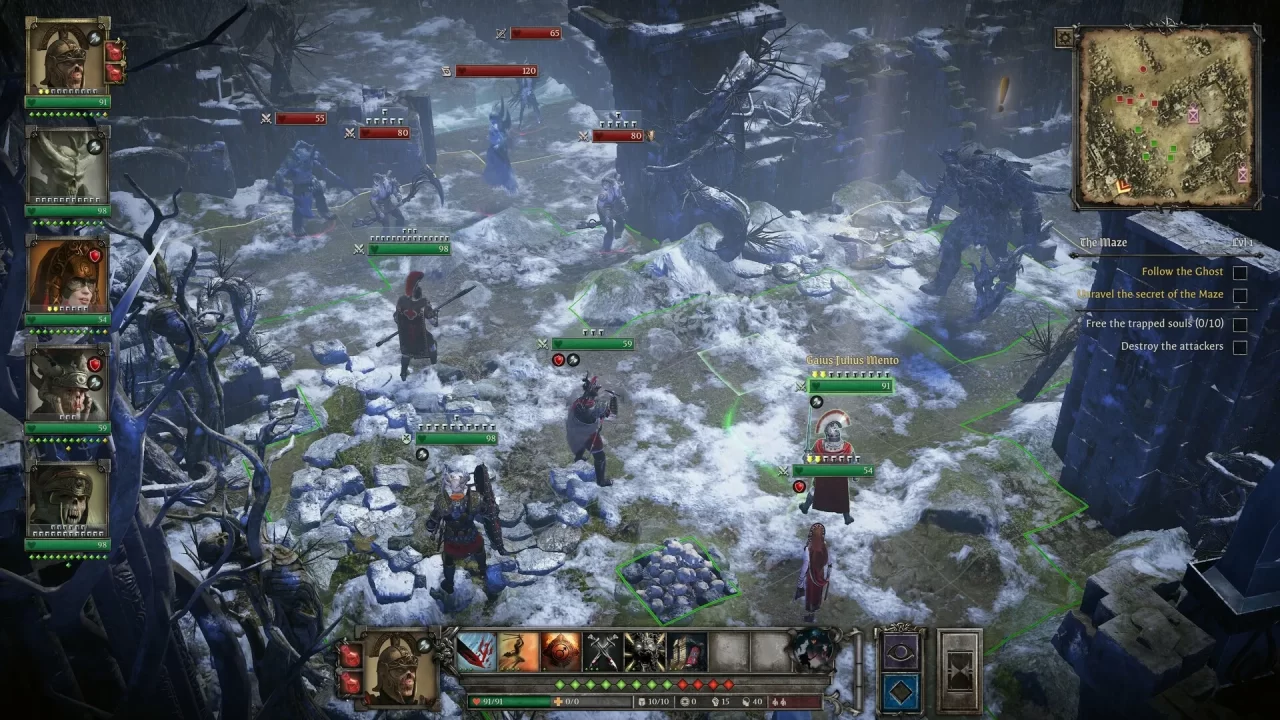The legends of King Arthur, Camelot, and the Lady of the Lake have been popular over the last few years, and a range of projects from bizarre action games to turn-based gacha are doubling down on these romantic influences. Neocore developed their own slant on the legend, King Arthur: Knight’s Tale, back in 2022 and the strategy RPG was well received. More recently, they have produced a different spin on the same systems and engine, through the stand-alone King Arthur: Legion IX. This latest game takes the themes and characters into Ancient Roman territory while still maintaining the flexible tactical systems, challenging combat, and darkly dour themes of its original inspiration. Having said that, longer-term fans will be wise to temper their expectations around how much Legion IX adds to the original game. Unlike their Roman namesakes, this legion is more iteration than innovation.
The story revolves around a powerful ancient leader, Gaius Julius Mento, the commander of Rome’s legendary Legion IX and a distant relative of Julius Caesar. Along with his undead soldiers, brought back from the dead realm of Tartarus to fight for their futures, he emerges in the fey land of Avalon and soon locates the fledgling city of Nova Roma. From this point, Gaius explores the surrounding area seeking a way to bring his boss, Emperor Septimus Sulla, into Avalon and then into the living world and the new glory of Rome. As he does this, he soon gets embroiled in the characters and mythology of Avalon, with plentiful callbacks to the original game. The narrative passes by easily enough, even if it suffers from the same clumsy writing and blunt characterization as the original.
Legion IX presents a melancholy setting, full of swirling mists, skeletal trees, and angry Pict warriors. There’s not a great deal of variety or point of difference from the original game, with a few reused areas. The Roman detail on the new enemy faction and player characters is nice and evokes the macabre sense of a legion of dead centurions, but there’s nothing that takes the graphic design to another level. Music and sound function similarly, and the voice acting maintains a melodramatic and over-the-top approach. Don’t expect much nuance here or any memorable musical tracks or moments.

Nuanced, well-crafted dialogue, you won’t find here.
However, the developers added a few twists to the robust turn-based combat. Firstly, the roster of characters (just six total) all boast new classes and abilities. Although these don’t radically change the tactical approach, some are more successful at providing variety than others. The sorcerous Flamen class, embodied in one of your delightfully evil advisors, offers strategies around causing damage over time to multiple enemies, mirroring damage between them, and generally weakening them for everyone else to mush. That he’s not a strong offensive weapon is not an issue.
Later stages in the game introduce Ultimate abilities. Each character has their own, ranging from summoning an abyssal ally to simply whaling on an enemy with multiple hits. Ultimates gain power from soul energy dropped by fallen enemies in battle and indicated with numerical counters signifying their value. Once this part of the game opens up, strategies to create optimum movement paths to collect soul energy, as well as deciding who to collect and when to activate an Ultimate, add to the tactical decisions. It’s vital for more challenging maps later on: the ability to flood a map with additional temporary doppelgangers is very useful to take the heat from a few hulking Formorians, for example.
Finally, battles make more use of barriers and terrain chokepoints than King Arthur: Knight’s Tale, and when coupled with enemy healing or spawn totems, this adds to the complexity and demands of combat, especially with the limited roster. In the original, there was more scope (depending on who you recruited or discovered) to pack out a squad with tanks, scouts, or mages, whereas the focus on each Legion IX character having a specific role makes the maps and objectives more demanding and engaging. Although it felt initially disappointing to have so few characters, this design decision ultimately serves the game well.

It’s grim, grimy and misty. Welcome to the vast majority of Legion IX maps!
There are a raft of different equipment runes, relics, and banners to find or purchase to further empower your characters, and all abilities have several unlockable bonuses to make them more efficient. As there are only six characters and six classes, each build can be unique and offers lots of tactical choice. It’s feasible to focus on empowering a few key abilities or to spread your resources across many, even if they aren’t as strong or cost more action points to use. There’s even scope to focus on a few key abilities and max out a range of passive skills, such as increasing your movement rate or enhancing a character’s physical and mental resistance. Taken as a whole, it’s a good system and the smaller cast of characters brings it into sharper relief than previously.
Shortly after the opening battles, the base-building elements return in a slightly leaner format. Although there are no wounds or injuries to contend with, there’s a blacksmith for equipment upgrades and two different merchants as pathways to improving characters. Edicts, which enforce a specific set of circumstances or advantages for an upcoming battle, also make a return provided you have the coin and resources. One new area is the Lararium, where collectable Lar busts can be activated. These marble statues provide both a boon and a disadvantage during fights. On one map, a Lar’s ability to restore 10% of damage dealt as health (even if campfire rests would not replenish health as a downside) worked well when there were several smaller battles and the crew could hit hard.
Perhaps the most disappointing aspect of the game is the lack of enemy variety. Fighting through waves of the same Picts, Lost, and Seelie adversaries feels very familiar, and even the mission objective variety can’t mask the familiarity. Coupled with the inherent dreariness of the setting, it leads to points where ploughing through a map to reveal new runes or a stash of precious relic dust is the main goal. The game does offer some cool new bad guys in the endgame, such as elemental sprites and a wider range of Fomorians, but it feels like it arrives too late. Issues around the fiddly UI and selecting characters in the battle maps persist, too. There were many times characters ended up going on an unintentional run and wasting action points for my liking, with no option to re-do.
I’m very aware that throughout this review, I’ve treated the game almost like a DLC, but Legion IX is a strange game in many ways. It feels like it was an offshoot design of the original game: a sort of parallel-world approach that leads to it being not only very similar but a step back from its predecessor in some cases. There’s no doubting that the morality system is simplified and the base-building has far fewer elements to manage. Even the combat, slick and effective though it is, only iterates around familiar systems; there’s nothing that alters the dynamics or shifts perceptions. In keeping with its tight focus, Legion IX is not a long slog either, and apart from choosing the Demonic or Humanist path and some tough final boss maps, there’s little else to justify a replay.
This genre and approach are my catnip, and I could happily play Legion IX again just to explore different character builds and attain the full demonic morality bonuses, but I suspect many gamers will bounce straight off it even if they liked the original. If you really enjoyed the original, and want more of the same, you’re in the right place. If you enjoyed the original but wished it addressed some of its issues or innovated on its designs, this trip to Nova Roma won’t provide solutions. You can decide whether you’ll come, what you think you’ll see, and if you think you’ll conquer. Veni, Vidi, Vici, indeed.



